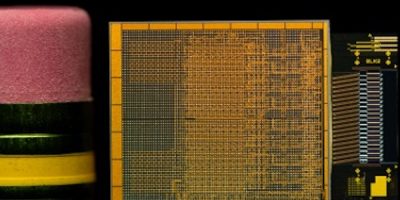Intel announces first fully integrated optical I/O chiplet
Intel’s Integrated Photonics Solutions (IPS) Group has announced the industry’s most advanced and first-ever fully integrated optical compute interconnect (OCI) chiplet co-packaged with an Intel CPU and running live data. Intel’s OCI chiplet represents a leap forward in high-bandwidth interconnect by enabling co-packaged optical input/output (I/O) in emerging AI infrastructure for data centres and high performance computing (HPC) applications.
This first OCI chiplet is designed to support 64 channels of 32 gigabits per second (Gbps) data transmission in each direction on up to 100 meters of fibre optics and is expected to address AI infrastructure’s growing demands for higher bandwidth, lower power consumption and longer reach. It enables future scalability of CPU/GPU cluster connectivity and novel compute architectures, including coherent memory expansion and resource disaggregation.
AI-based applications are increasingly deployed globally, and recent developments in large language models (LLM) and generative AI are accelerating that trend. Larger and more efficient machine learning (ML) models will play a key role in addressing the emerging requirements of AI acceleration workloads. The need to scale future computing platforms for AI is driving exponential growth in I/O bandwidth and longer reach to support larger processing unit (CPU/GPU/IPU) clusters and architectures with more efficient resource utilisation, such as xPU disaggregation and memory pooling.
Electrical I/O supports high bandwidth density and low power, but only offers short reaches of about one meter or less. Pluggable optical transceiver modules used in data centres and early AI clusters can increase reach at cost and power levels that are not sustainable with the scaling requirements of AI workloads. A co-packaged xPU optical I/O solution can support higher bandwidths with improved power efficiency, low latency and longer reach – exactly what AI/ML infrastructure scaling requires.
The fully Integrated OCI chiplet leverages Intel’s silicon photonics technology and integrates a silicon photonics integrated circuit (PIC), which includes on-chip lasers and optical amplifiers, with an electrical IC. The OCI chiplet demonstrated at OFC was co-packaged with an Intel CPU but can also be integrated with next-generation CPUs, GPUs, IPUs and other system-on-chips (SoCs).
This first OCI implementation supports up to 4 terabits per second (Tbps) bidirectional data transfer, compatible with peripheral component interconnect express (PCIe) Gen5. The live optical link demonstration showcases a transmitter (Tx) and receiver (Rx) connection between two CPU platforms over a single-mode fibre (SMF) patch cord. The CPUs generated and measured the optical Bit Error Rate (BER), and the demo showcases the Tx optical spectrum with 8 wavelengths at 200 gigahertz (GHz) spacing on a single fibre, along with a 32 Gbps Tx eye diagram illustrating strong signal quality.
The current chiplet supports 64 channels of 32 Gbps data in each direction up to 100 meters (though practical applications may be limited to tens of meters due to time-of-flight latency), utilising eight fibre pairs, each carrying eight dense wavelength division multiplexing (DWDM) wavelengths. The co-packaged solution is also remarkably energy efficient, consuming only 5 pico-Joules (pJ) per bit compared to pluggable optical transceiver modules at about 15 pJ/bit. This level of hyper-efficiency is critical for data centres and high-performance computing environments and could help address AI’s unsustainable power requirements.
These PICs were packaged in pluggable transceiver modules, deployed in large data centre networks at major hyperscale cloud service providers for 100, 200, and 400 Gbps applications. Next generation, 200G/lane PICs to support emerging 800 Gbps and 1.6 Tbps applications are under development.
Intel is also implementing a new silicon photonics fab process node with state-of-the-art device performance, higher density, better coupling and vastly improved economics. Intel continues to make advancements in on-chip laser and semiconductor optical amplifier (SOA) performance, cost (greater than 40% die area reduction) and power (greater than 15% reduction).




